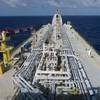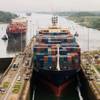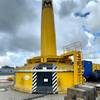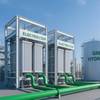Even a cursory analysis of the performance and capacity specifications of the Auto Express 66 catamaran “Bocayna Express” makes it obvious that Austal Ships has provided Fred. Olsen, SA with a class-leading ferry that reflects each company’s position at the forefront of the international fast ferry industry.
Now that the 66 metre vehicle-passenger catamaran has completed sea trials and been handed over, the Australian shipbuilder and Spanish ferry operator are pleased to confirm that both speed and deadweight are higher than previously revealed. During construction every effort was made to save weight and a significant reduction in displacement has resulted in a fantastic improvement in maximum deadweight, which is in excess of 300 tonnes. Consequently, on sea trials the aluminium fast ferry achieved speeds in excess of 40 knots lightship and just under 36 knots loaded. The originally stated contract speed was 31 knots.
“This performance translates into transport efficiency that is noticeably higher than previous fast ferries in this size and speed range,” said Glenn Williams, Austal’s Sales and Product Development Manager.
“With 19 per cent greater car capacity “Bocayna Express” is less than nine per cent slower than a similarly sized monohull fast ferry that has 35 per cent more power. The benefits to the operator’s bottom line are obvious.”
“Bocayna Express” is powered by two 12-cylinder and two 18-cylinder MAN B&W VP185 diesels which combine to provide a maximum output of 11,600kW. Located outboard in each engine room, the more powerful diesels drive Kamewa 90 SII waterjets while the inboard engines are connected to Kamewa 80 SII waterjets.
Austal has also developed versions of the Auto Express 66 that feature more powerful engines for even higher speeds and mezzanine vehicle decks to increase capacity up to 129 cars. Glenn Williams says these variants also have significantly superior performance than competing monohulls.
“Under realistic loading conditions, the Auto Express 66 would be 1.5 to 2 knots faster than a monohull that has far less car capacity and more installed power. Overall that monohull will use 85 per cent more fuel per car per mile while travelling slower – these figures speak for themselves.”
Visiting Austal’s Henderson shipyard in the early part of September for the final trials of the vessel, Mr Fred Olsen Jnr, Executive Chairman of Fred. Olsen, SA said he was delighted with the new addition to his fleet, which currently consists of three catamaran fast ferries and two conventional monohulls, one of which will be replaced by “Bocayna Express”.
The 450 passenger capacity catamaran will operate across the Bocayna Strait between the islands of Lanzarote and Fuerteventura and replaces a 14 knot monohull Ro-Pax ferry. Its design was specifically developed taking the route’s shallow waters, strong winds and physical ship size restrictions into account. As the crossing is only nine nautical miles, Fred. Olsen, SA has opted not to fit a full motion control system to “Bocayna Express”. While the transom-mounted interceptors and Austal hull shape are expected to provide the necessary level of comfort, forward T-foils can be easily installed at a later date if it is deemed necessary.
The introduction of the new fast ferry will enable Fred. Olsen, SA to double the frequency of the service. Scheduled crossing time, including manoeuvring in port, is just 20 minutes, and loading and unloading will be completed in just 10 minutes.
Short turnaround times are facilitated by the straightforward layout of the drive-through vehicle deck, which is open at both bow and stern to save weight and reduce construction cost. Rated for axle loads up to 12 tonnes and providing clear height of 4.2 metres, the deck can carry trucks and buses in addition to cars and motorcycles. Maximum capacity is 69 cars and there are 110 lane-metres for heavy vehicles.
Austal designed the Auto Express 66 so that it would seamlessly integrate with Fred. Olsen, SA’s existing terminal facilities. The ferry’s forward vehicle ramp is designed to support the weight of both the shore ramp and the transferring vehicles and is raised and lowered using two hydraulic capstans. The arrangement at the stern is simplicity itself, with the bulwark folding down to allow the shore-based ramp to lock directly onto the vehicle deck.
External stairs lead up to an open aft deck where 80 passengers can sit and enjoy the Canary Islands sun, views over the stern and refreshments from the bar on the short crossing. The passenger deck can also be reached via internal stairs amidships or using the lift installed on the starboard side.
Once inside the cabin it is immediately apparent that passenger comfort and fitout quality have not been sacrificed in achieving the economy and practicality that underpins the operator appeal of the Auto Express 66. The floors are covered with plush wool carpet in combination with other high quality flooring materials for the wide walkways and other high traffic areas. Similarly prudent choices have been made in selecting the ceilings and aluminium honeycomb panelling.
One of the cabin’s main features in terms of passenger amenities is the lounge area located between the bar aft and the shop and transverse walkway amidships. Fitted out with comfortable armchairs arranged around circular pedestal tables, the lounge is the ideal place for passengers to relax, partake of warm or cold beverages from the adjacent bar, and talk with friends.
In contrast to the predominantly blue and cream colour scheme, the tub style armchairs feature bright red patterned wool covers with leather trims. Flooded with natural light from a large skylight, this area is also delineated from the rest of the passenger cabin by the use of polished metal handrails, a different ceiling style and the bordering walkways.
Outboard of the lounge area are rows of four aircraft style seats then another aisle and pairs of seats alongside the windows. The seats come complete with fold-down tables and information pockets and the use of alternating light and dark blue covers helps to create a more visually stimulating environment.
The same seating layout is repeated in the forward saloon that surrounds a central utilities block incorporating the shop aft, crew mess in the starboard forward quarter and an electrical compartment and stairs to the bridge on the port side. The central section of seats is again differentiated by using red patterned covers and faces an expanse of aft raked windows running the full width of the cabin and providing passengers with views over the bows.
“The interiors were designed following the same fundamental patterns that were used on our three other catamarans, since the design has proved to be very pleasing to our passengers while at the same time being extremely practical,” Mr Olsen said.
“Bocayna Express” will operate with a crew of 16 including a three-person bridge team. Their modern workspace places the Captain on the centreline flanked by the Chief Engineer to port and First Officer to starboard. In a departure from normal Austal practice, but in keeping with Fred. Olsen, SA’s wishes, the bridge does not have wing stations. Instead, the Captain uses the ferry’s CCTV system to monitor position while berthing, controlling the ship from either the main command station or the secondary manoeuvring console which faces aft.
Featured among the array of modern electronics on the carefully arranged bridge is the Marine Link ship control and monitoring system that was developed by Austal Ships and features on most of its contemporary deliveries. This system allows extensive monitoring of machinery and systems throughout the vessel as well as providing a powerful on-line system to manage all user manuals as well as other ship’s drawings and documentation.
Looking to the future, Glenn Williams said Austal had already benefited from working with Fred. Olsen, SA and that this was set to continue with the construction of the ground-breaking 126.7 metre Auto Express trimaran cargo-vehicle-passenger ferry which was ordered in June.
“By working together we have achieved a great result with the 66 metre catamaran, and I’m sure that, like the trimaran, it will make many operators sit up and take notice. It is a top quality yet extremely affordable solution for operators who wish to provide a high-speed alternative to smaller conventional Ro-Pax ferries, and also a great starting point for new fast ferry operations,” he said.
Sponsored Content
Safer Starts Here: Build Ships, Protect Crews

July 2025
 Read the Magazine
Read the Magazine

 Read the Magazine
Read the Magazine
This issue sponsored by:

Rising Shipyard Stars: Ashley Cordiale's Journey from the Sea to Estimator at Detyens
Subscribe for
Maritime Reporter E-News
Maritime Reporter E-News is the maritime industry's largest circulation and most authoritative ENews Service, delivered to your Email five times per week







